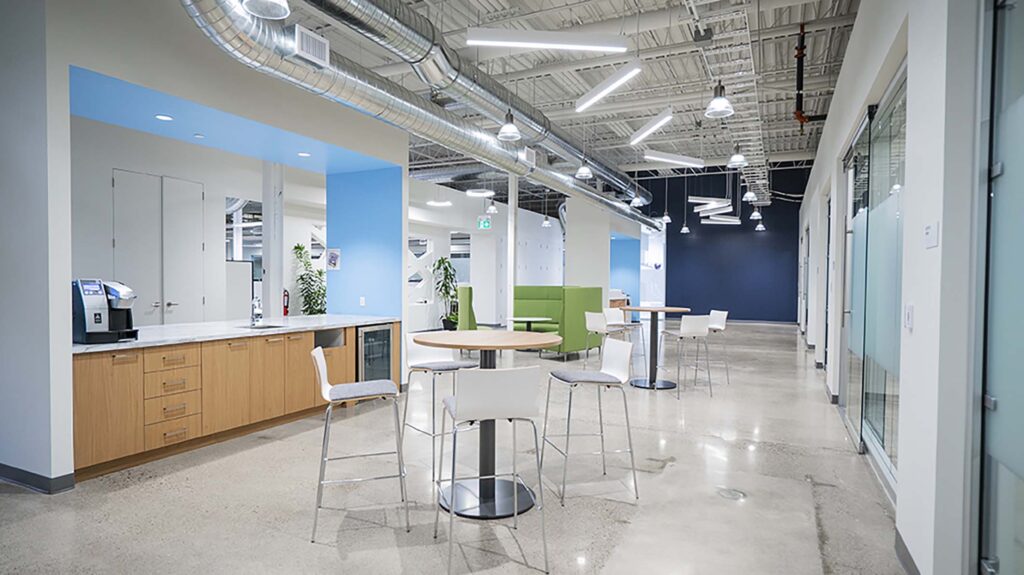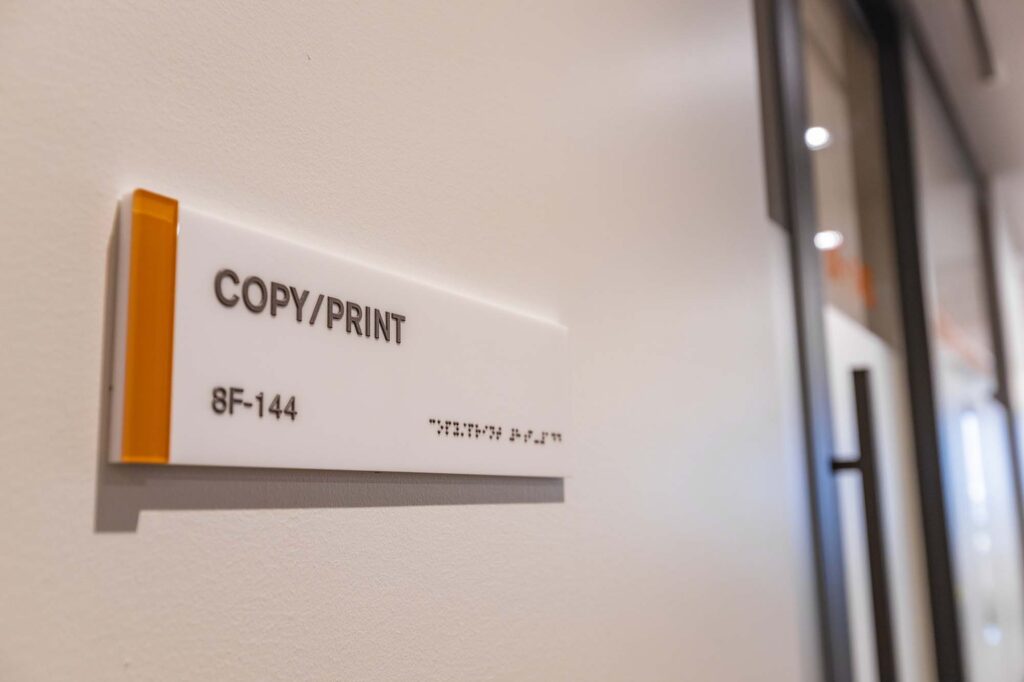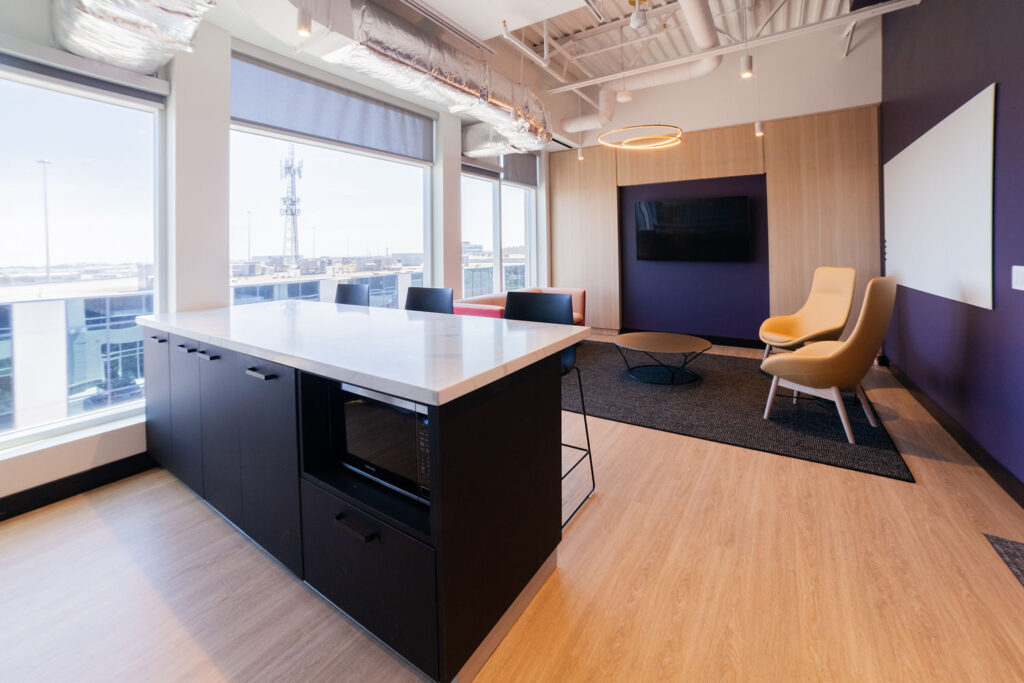for one and one for all!” In 1844, surely Dumas was referring to loyalty, not to universal design when he coined this phrase, but put in today’s context, the intention and philosophy behind this thinking sure does fit!
Almost all corporations indicate that they want to foster a culture of diversity and inclusiveness. It shows up in corporate mission statements, on websites and in RFPs. But universal, or inclusive, design is not only a feel-good nice-to-do; in fact, there is research which actually shows that a diverse workforce helps organizations increase profits, drive innovation and outperform their peers.
Okay, so it is proven that being able to ‘walk-the-walk’ is key when it comes to accommodating a diverse workforce and offering a culture of inclusivity. So how can Managers incorporate universal design features into their workspace to allow flexible design for all? Thankfully, it doesn’t have to be complicated in order to be effective.
In 1977, a report was published, entitled, “The Principles of Universal Design”, by a number of universal design advocates out of The Center for Universal Design at NC State University. (Yes, there is such a Center!). In this report, the authors promote seven principles which still very much apply today and serve as a yard stick for not only workspace design but general purpose everyday use in products, our homes and the environment at large. These seven design principles are as follows: There’s no better test for this principle than when one tries to design for a classroom, and meet the provisions of privacy, security, and equally available spaces to learn to all users. Have a look at how we designed with equitable use in mind with Loyalist College and their redesigned Media Resource Facility, and brought elements into the space that emphasized equitable learning environments.
execute. Challenging still, is ensuring the user-experience is reinforced with the ease of choice in utilizing the space in whatever format they wish. Check out how we successfully achieved this design principle in our project with the MaRS Discovery District – CIBC Live Lounge. Creating a flexible lounge for tenants and the MaRS community to work and meet on a drop-in basis, but also have the flexibility of converting the space into an event venue.
The way we interpret how to use a space is a critical part of determining if the design intent for said space was successful or not. Therefore ensuring the functionality of the space is as easy to understand as possible, regardless of the user’s experience or knowledge of the space, is an essential part of a successful design. Check our this design principle in action with Axonify’s office redesign. Mayhew applied various colours from Axonify’s brand through bright coloured walls, acoustic floating clouds, vibrant floor accents to help indicate purpose and intended use of their office space.
It is no secret that people have short attention spans. Which presents a special challenge for designers when trying to present essential information about a space and it’s intended use. Using different modes (pictorial, verbal, or tactile) of presenting essential information or is one great example of switching visual aids up in order to grasp a user’s attention when they need to know something about the space or product in front of them. Check out our project with Bell Media, and how a simple change in carpet tile pattern can be an easy way-finding indicator for newcomers to the office space.
We have all been there before – working on an over crowded desk, filled with papers, power cords, and electronics meant for your day-to-day activities. And everything seems to be co-existing in your cramped workstation well, until…the unfaithful moment that you accidentally spill your coffee all over your papers and monitor! If only it was not buried under all that clutter, this whole accident could have been avoided entirely. This design principle addresses the need for elements or precautionary measures to minimize potentially hazardous errors. Whether that means redesigning an assembly line for a manufacturing plant, or making room for extra storage to avoid clutter in an administrative office, the same school of through applies. Have a look at our project with Mitchell Plastics, and how the designers at Mayhew strategically used storage units to create a area for impromptu meetings and collaberative work.
Ergonomics in interior design is the backbone of the workplace (pun intended). And with people spending upwards of 50% of their day in the office, it pays dividends to have a workstation that considers the ideal working positions for the human body. Have a look at our primary furniture supplier’s latest workstation collection, The Axel. A tile-based furniture system that it built to be as versatile and unique as the people sitting in them!
The key factor in this principle is the functions of the people within a workplaces, and what appropriate ergonomic and work space considerations are needed to be successful ones day-to-day role. Have a look at how the designers at Mayhew accommodated an interesting mix of traditional workspace design, while considering the needs for appropriate space utilization and workflow for vehicles in our projects with Kia’s Motors dealerships nation-wide.
With these seven design principles in mind, designing for diversity and inclusiveness is a lot about offering choice and flexibility with working conditions, presenting different technological solutions and being open to small changes that could go a long way in terms of a satisfied workforce. And a happy, satisfied workforce is a productive workforce which, in turn, leads to business results.
Some obvious examples of designing for diversity are dropped curbs and ramps for accessibility needs. Other needs can be more subtle, like providing lever handles (versus knobs) so that operation of doors, storage units and other equipment can be managed with a closed fist for those with limited dexterity. And then there are larger items that may be considered which require a slightly larger investment but have been proven to pay back in terms of time, productivity, health and wellness. These items can include sit-to-stand desks, adjustable chairs and desks, ergonomic keyboard and computer supports, and smart technology that can allow team members to adjust their own workspace based on their personal preferences, such as heating, glare and lighting. All of these details – big and small – contribute to an employee’s sense of wellbeing, feeling comfortable, a sense of belonging, mental wellness and ultimately, loyalty to the firm that is taking care of their needs. And a loyal employee is one who cares about the wellbeing of the firm, its work and the surrounding team, the vision for all Managers, Executives and Boards.
Further, not only is designing for diversity a way to accommodate accessibility needs, it allows an organization to act in accordance with the provincial accessibility legislation, “the Accessibility for Ontarians with Disabilities Act (AODA)”. This act is meant to eliminate barriers to give the ability for anyone to access, exit and navigate a building independently – including, of course, functional washrooms.
Lastly, beyond providing barrier-free design, designing for diversity is also about a firm’s commitment to its team members in respecting cultural, personality and generational needs and differences. A workspace design has succeeded when not only have accessibility needs been accommodated, but when it provides an inclusive environment that fosters a safe space where people feel empowered; where ideas will be considered and valued; where innovative thoughts are encouraged; where team members come first. When an organization has achieved an atmosphere that promotes collaboration, creative work, idea sharing and inclusion, it has been successful in designing for diversity.
Designing for diversity does not have to be hard or expensive. If you are considering an office redesign to incorporate universal design principles, contact us for a FREE workplace assessment (valued at $2,000.00). The interior designers at Mayhew can help optimize your workplace based on your organization’s needs, timeline and budget. You’ll love the results, and so will your team.



